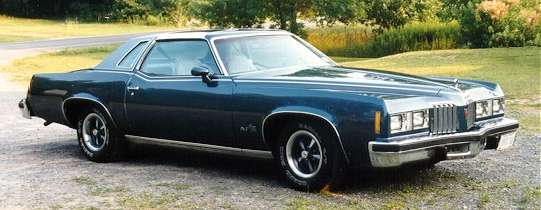
The 1977 Grand Prix SJ. |
1977
The 1977 model year rolled in with high hopes for Pontiac. The Grand Prix received a minor face-lift for its last year on this platform.
The front end was revised slightly, and the "waterfall" effect of the grille was de-emphasized somewhat. The fine mesh treatment was traded for five vertical bars on each side, and the taillights were slightly updated. The T-top from the previous year became a regular option, and the Honeycomb wheels were replaced with new "snowflake"-style aluminum wheels.
The engine lineup was the most confusing it had ever been. Depending on where you lived, you might get a Pontiac, Chevrolet or Oldsmobile mill. There was a separate 49-state engine lineup, as well as a California and high-altitude lineup.
The base GP engine for '77 was the new 301 Pontiac V8. It was a short-deck whose basic block dimensions were quite similar to the old 303 Trans-Am race motor, though it was not nearly as beefy. Its deck was 1.12 inches shorter than the 350 or 400. Connecting rods measured 6.05 inches—vs. 6.625 inches for its larger brothers. The new engine shared the same 3-inch main journal diameters as the 350 and 400. The block, heads and intake manifold were very lightweight castings, and the crankshaft only had eounterweights on each end in the interest of weight reduction.
The result: The 301 came in at a very svelte 452 pounds, or about the same as Buick's 231 V6! It produced 135 net horsepower at 3800 rpm,
with 240 lbs.-ft. of torque at 2000. While not earth-shattering, the power level was similar to other 5-liter V8s of the time, and it had the
weight advantage. Less weight is the same as more horsepower.
Next up the option ladder was the "5.7-liter"
V8. Depending on the plant, the time at which the car was built and the zone to which it was delivered, a GP might get a 350 Pontiac, a
350 Olds or a 350 Chevy.
There were a couple of reasons for this. The first problem was that the 350 Pontiac would
not pass the stricter California and high-altitude emissions standards. In its place, Pontiac substituted the 350 Olds engine.
Since the Olds engine was cleaner-running, it was in demand. Soon, there weren't enough
to go around—Oldsmobile didn't even have enough for its Cutlasses. So, the Olds 350s were replaced with Chevy 350s.
The same thing happened with the top-option 400 Pontiac and the cleaner-burning 403
Olds.
All of this interdivisional engine juggling resulted in a class-action suit brought against GM
by some disgruntled owners who got engines that were not what they had ordered. It turned into a mini-media blitz, and the only people
who made out on the fiasco were the dealers. They "took back" the cars with mismatched engines—but only after setting a mileage
charge that often cost the consumer as much as $2,000. Then they'd resell the low-mileage used car for top dollar. Good work if you
can find it ...
Despite the incestuous engine lineup, 1977 proved to be the best year ever for Grand Prix
sales. Total production was 288,430 units—of which 168,247 were standard GPs, 66,741 were LJs, and 53,442 were SJs.
NEXT >
|
|